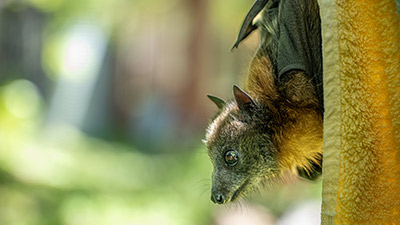Grey-headed Flying-fox (Pteropus poliocephalus)

Description
- The Grey-headed Flying-fox is one of the largest bats in the world.
- Its fur is generally medium to dark grey, with lighter tips, and they have a distinctive orange or russet-coloured collar around their necks.
- Its wing membranes are black, and have fur down to the ankles, unlike the Black Flying-fox which has bare legs below the knee.
- Adult males weigh between 750 g-1 kg. Adult females are a bit lighter, weighing between 650-800 g.
- Despite the weight difference, both males and females have similar forearm lengths of 155-175 mm.
- It's an important species for pollinating flowers and spreading seeds in native forests. It can travel 50 km in one night spreading seeds long distances.
- It eats the flowers of Eucalyptus, Banksia, Melaleuca, and fruits from rainforests.
- It eats food from backyards in cities and towns when native food isn’t available.
- Grey-headed flying-foxes live in large colonies in trees and dense vegetation.
- Females give birth to 1 baby at a time, which can live up to 6-7 years.
Find out more about the Grey-headed Flying-fox on Canberra NatureMapr.
Where to find them
The Grey-headed Flying-fox is native to eastern Australia. It’s found from Bundaberg in Queensland to Melbourne in Victoria, and the eastern coast to the western slopes of NSW.
The range of colonies in the north have shrunk about 500 km over the past 100 years. More colonies are now in the south.
The bat now visits the ACT during summer and autumn and there are some individual bats that visit occasionally over winter periods. In 2003, a large colony of around 100 bats set up at Commonwealth Park, and by 2011, this increased to over 6,000. In October 2013, a maternity colony arrived in Canberra to give birth.
The Grey-headed Flying-fox lives in various habitats, including tropical forests, woodlands, swamps, mangroves, and fruit plantations. It can also be found in urban areas where it can find food and places to roost.
Conservation threats
Threats to the Grey-headed Flying-fox include:
- loss of food and roosting areas due to clearing native vegetation for farming, forestry and urban development
- inappropriate fruit netting use
- climate change increasing the number of extreme hot days.
Conservation status
- International – Vulnerable (International Union for Conservation of Nature Red List).
- National – Vulnerable (Environment Protection and Biodiversity Conservation Act 1999).
- Australian Capital Territory – Vulnerable (Nature Conservation Act 2014).
Conservation actions
Conservation aims to reduce threats to the Grey-headed Flying-fox and support its recovery. Conservation efforts aim to:
- protect the species' role in seed dispersal and pollination
- improve the information available to help recover the species and increase public awareness and understanding
- identify and protect important roosting and feeding habitats, ensuring no tree clearing without expert advice or for safety reasons
- develop non-harmful ways to manage camps in problem areas
- educate the public about the species, promote recovery actions, and encourage community involvement.
